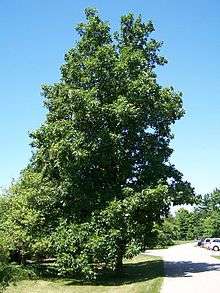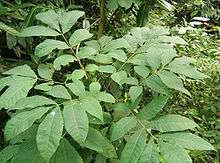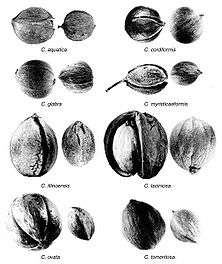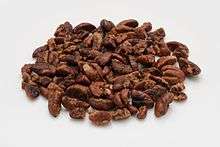Hickory
| Hickory | |
|---|---|
 | |
| Hickory at Morton Arboretum Accession 29-U-10 | |
| Scientific classification | |
| Kingdom: | Plantae |
| (unranked): | Angiosperms |
| (unranked): | Eudicots |
| (unranked): | Rosids |
| Order: | Fagales |
| Family: | Juglandaceae |
| Subfamily: | Juglandoideae |
| Tribe: | Juglandeae |
| Subtribe: | Caryinae[1] |
| Genus: | Carya Nutt. |
| Type species | |
| Carya tomentosa (Poir.) Nutt.[2] | |
| Species | |
|
See text | |
| Nutritional value per 100 g (3.5 oz) | |
|---|---|
| Energy | 2,749 kJ (657 kcal) |
|
18.25 g | |
| Dietary fiber | 6.4 g |
|
64.37 g | |
| Saturated | 7.038 g |
| Monounsaturated | 32.611 g |
| Polyunsaturated | 21.886 g |
|
12.72 g | |
| Tryptophan | 0.139 g |
| Threonine | 0.422 g |
| Isoleucine | 0.576 g |
| Leucine | 1.027 g |
| Lysine | 0.497 g |
| Methionine | 0.300 g |
| Cystine | 0.271 g |
| Phenylalanine | 0.713 g |
| Tyrosine | 0.454 g |
| Valine | 0.730 g |
| Arginine | 2.086 g |
| Histidine | 0.389 g |
| Alanine | 0.662 g |
| Aspartic acid | 1.368 g |
| Glutamic acid | 2.885 g |
| Glycine | 0.708 g |
| Proline | 0.571 g |
| Serine | 0.806 g |
| Vitamins | |
| Thiamine (B1) |
(75%) 0.867 mg |
| Riboflavin (B2) |
(11%) 0.131 mg |
| Niacin (B3) |
(6%) 0.907 mg |
| Pantothenic acid (B5) |
(35%) 1.746 mg |
| Vitamin B6 |
(15%) 0.192 mg |
| Folate (B9) |
(10%) 40 μg |
| Vitamin B12 |
(0%) 0.00 μg |
| Vitamin C |
(2%) 2.0 mg |
| Minerals | |
| Calcium |
(6%) 61 mg |
| Iron |
(16%) 2.12 mg |
| Magnesium |
(49%) 173 mg |
| Manganese |
(220%) 4.610 mg |
| Phosphorus |
(48%) 336 mg |
| Potassium |
(9%) 436 mg |
| Sodium |
(0%) 1 mg |
| Zinc |
(45%) 4.31 mg |
| Other constituents | |
| Water | 2.65 g |
|
| |
| |
|
Percentages are roughly approximated using US recommendations for adults. Source: USDA Nutrient Database | |
Hickory (from Powhatan) is a type of tree, comprising the genus Carya (Ancient Greek: κάρυον "nut"). The genus includes 17–19 species of deciduous trees with pinnately compound leaves and large nuts. Five or six species are native to China, Indochina, and India (State of Assam), as many as 12 are native to the United States, four are found in Mexico, and two to four are from Canada. Hickory flowers are small, yellow-green catkins produced in spring. They are wind-pollinated and self-incompatible. The fruit is a globose or oval nut, 2–5 cm (0.79–1.97 in) long and 1.5–3 cm (0.59–1.18 in) diameter, enclosed in a four-valved husk, which splits open at maturity. The nut shell is thick and bony in most species, and thin in a few, notably C. illinoinensis; it is divided into two halves, which split apart when the seed germinates.
Beaked hickory (Annamocarya sinensis) is a species formerly classified as Carya sinensis, but now adjudged in the monotypic genus Annamocarya.
Species and classification

In the APG system, genus Carya (and the whole Juglandaceae family) has been recently moved to the Fagales order.
- Asia
- Carya sect. Sinocarya – Asian hickories
- Carya dabieshanensis M.C. Liu – Dabie Shan hickory (may be synonymous with C. cathayensis)
- Carya cathayensis Sarg. – Chinese hickory
- Carya hunanensis W.C.Cheng & R.H.Chang – Hunan hickory
- Carya kweichowensis Kuang & A.M.Lu – Guizhou hickory
- Carya poilanei Leroy - Poilane's hickory
- Carya tonkinensis Lecomte – Vietnamese hickory[3]
- North America
- Carya sect. Carya – typical hickories
- Carya floridana Sarg. – Scrub hickory
- Carya glabra (Mill.) Sweet – Pignut hickory, pignut, sweet pignut, coast pignut hickory, smoothbark hickory, swamp hickory, broom hickory
- Carya myristiciformis (F.Michx.) Nutt. – Nutmeg hickory, swamp hickory, bitter water hickory
- Carya ovalis (Wangenh.) Sarg. – Red hickory, spicebark hickory, sweet pignut hickory (treated as a synonym of C. glabra by Flora N. Amer.)
- Carya ovata (Mill.) K.Koch – Shagbark hickory
- Carya ovata var. ovata – Northern shagbark hickory
- Carya ovata var. australis – Southern shagbark hickory, Carolina hickory (syn. C. carolinae-septentrionalis)
- Carya laciniosa (Mill.) K.Koch – Shellbark hickory, shagbark hickory, bigleaf shagbark hickory, kingnut, big shellbark, bottom shellbark, thick shellbark, western shellbark
- Carya pallida (Ashe) Engl. & Graebn. – Sand hickory
- Carya texana Buckley – Black hickory
- Carya tomentosa (Poir.) Nutt. – Mockernut hickory (syn. C. alba)
- †Carya washingtonensis - Manchester Extinct Miocene
- Carya sect. Apocarya – pecans
- Carya aquatica (F.Michx.) Nutt. – Bitter pecan or water hickory
- Carya cordiformis (Wangenh.) K.Koch – Bitternut hickory
- Carya illinoinensis (Wangenh.) K.Koch – Pecan
- Carya palmeri W.E. Manning – Mexican hickory

Ecology
Hickory is used as a food plant by the larvae of some Lepidoptera species. These include:
- Luna moth (Actias luna)
- Brown-tail (Euproctis chrysorrhoea)
- Coleophora case-bearers, C. laticornella and C. ostryae
- Regal moths (Citheronia regalis), whose caterpillars are known as hickory horn-devils
- Walnut sphinx (Amorpha juglandis)
- The Bride (nominate subspecies Catocala neogama neogama)
The hickory leaf stem gall phylloxera (Phylloxera caryaecaulis) also uses the hickory tree as a food source. Phylloxeridae are related to aphids and have a similarly complex life cycle. Eggs hatch in early spring and the galls quickly form around the developing insects. Phylloxera galls may damage weakened or stressed hickories, but are generally harmless.
Deformed leaves and twigs can rain down from the tree in the spring as squirrels break off infected tissue and eat the galls, possibly for the protein content or because the galls are fleshy and tasty to the squirrels. The pecan gall curculio (Conotrachelus elegans) is a true weevil species also found feeding on galls of the hickory leaf stem gall phylloxera.
The banded hickory borer (Knulliana cincta) is also found on hickories.
Fruit
Some fruits are borderline and difficult to categorize. Hickory nuts (Carya) and walnuts (Juglans) in the Juglandaceae family grow within an outer husk; these fruits are sometimes considered to be drupes or drupaceous nuts, rather than true botanical nuts. "Tryma" is a specialized term for such nut-like drupes.[4][5]

Uses

Hickory wood is very hard, stiff, dense and shock resistant. There are woods that are stronger than hickory and woods that are harder, but the combination of strength, toughness, hardness and stiffness found in hickory wood is not found in any other commercial wood.[6] It is used for tool handles, bows, wheel spokes, carts, drumsticks, lacrosse stick handles, golf club shafts (sometimes still called hickory stick, even though made of steel or graphite), the bottom of skis, walking sticks and for punitive use as a switch (like hazel), and especially as a cane-like hickory stick in schools and use by parents. Paddles are often made from hickory. This property of hickory wood has left a trace in some Native American languages: in Ojibwe, hickory is called "mitigwaabaak", a compound of mitigwaab "bow" and the final -aakw "hardwood tree" [7]
Baseball bats were formerly made of hickory, but are now more commonly made of ash. Hickory is replacing ash as the wood of choice for Scottish shinty sticks (also known as camans). Hickory was extensively used for the construction of early aircraft.
Hickory is also highly prized for wood-burning stoves and chimineas,[8] because of its high energy content. Hickory wood is also a preferred type for smoking cured meats. In the Southern United States, hickory is popular for cooking barbecue, as hickory grows abundantly in the region, and adds flavor to the meat.
Hickory is sometimes used for wood flooring due to its durability in resisting wear and character. Hickory wood is not noted for rot resistance.
A bark extract from shagbark hickory is also used in an edible syrup similar to maple syrup, with a slightly bitter, smoky taste.
The nuts of some species are palatable, while others are bitter and only suitable for animal feed. Shagbark and shellbark hickory, along with pecan, are regarded by some as the finest nut trees.
When cultivated for their nuts, clonal (grafted) trees of the same cultivar cannot pollinate each other because of their self-incompatibility. Two or more cultivars must be planted together for successful pollination. Seedlings (grown from hickory nuts) will usually have sufficient genetic variation.

See also
References
- ↑ P. S. Manos; D. E. Stone (2001). "Evolution, phylogeny and systematics of the Juglandaceae". Annals of the Missouri Botanical Garden. 88: 231–269. doi:10.2307/2666226.
- ↑ "Carya Nutt.". TROPICOS. Missouri Botanical Garden. Retrieved 2009-10-19.
- ↑ "Subordinate Taxa of Carya Nutt.". TROPICOS. Missouri Botanical Garden. Retrieved 2009-10-19.
- ↑ Identification Of Major Fruit Types
- ↑ Fruits Called Nuts
- ↑ Important Trees of Eastern Forests, USDA, 1974
- ↑ Valentine, Rudolph 2001. Nishnaabemwin Grammar, Toronto: University of Toronto Press. p.485).
- ↑ "Chiminea Woods: Pinon, Apple, and Hickory—Oh My!".
Bibliography
- Philips, Roger. Trees of North America and Europe, Random House, Inc., New York ISBN 0-394-50259-0, 1979.
External links
| Wikimedia Commons has media related to Carya. |
| Wikisource has the text of the 1911 Encyclopædia Britannica article Hickory. |
- Flora of North America: Carya
- Flora of China: Carya
- USDA Agricultural Research Service: Carya
- Edibility of different species' nuts, from a snack food manufacturer
- Comparison of eastern North American hickories at bioimages.vanderbilt.edu
- Comparison of hickory nuts at bioimages.vanderbilt.edu
- USDA Plants Database Profile for Carya (hickory)